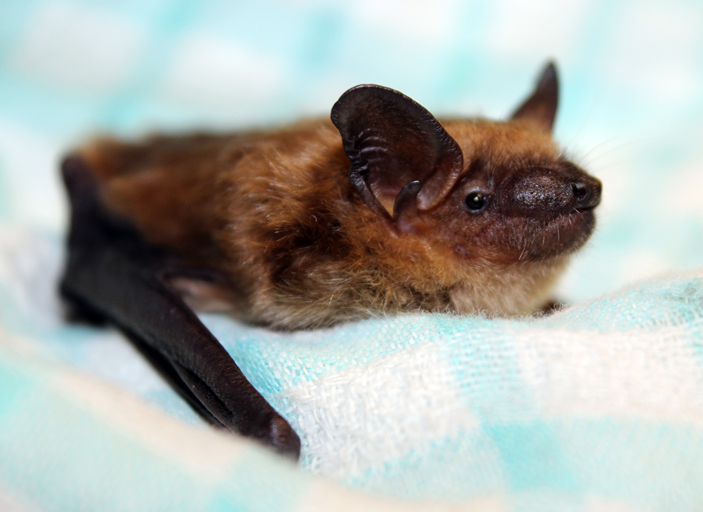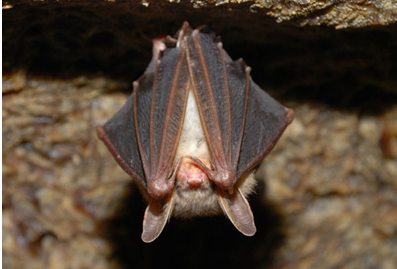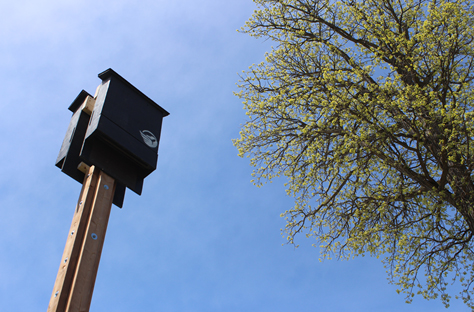|
|

|
  
Features
Update 2020/7/5
Endangered Species: Bats
brought to you in part by

WHY ARE BATS DISAPPEARING IN CANADA?
By Suzanne Forcese

The Little Brown Bat is on the Endangered List in Canada - Photo Courtesy Canadian Wildlife Federation Endangered Species
Sometimes feared, greatly misunderstood, and representing 20 % of all mammals, the bat is the only mammal in the world that can fly. A total of 1400 known species of bats can be found dispersed on every continent except Antarctica. Canada is home to 19 species. Bats busily eat up their own body-weight worth of agricultural pests on any given night, saving farmers billions of dollars. These creatures also pollinate 500 species of plants including many popular food crops such as bananas, cacao, mangos, peaches and figs. Without bats, there would be no tequila, as the beverage’s main ingredient is from agave. The plant lures these important nocturnal pollinators with blooms that only appear after sunset.
Fruit-eating bats could also serve an important role in mitigating the wild-fire deforestation impacts of climate change. In fact, German scientists are engaging bats to kick-start natural reforestation in the tropics by installing artificial bat roosts in deforested areas. Bats defecate while regularly flying up to 350 km in one night. As they fly over ravaged landscapes they drop seeds left over from digested fruit mixed in with their nitrogen rich guano (bat manure).
|

Bats roost upside down because they are
unable to launch into flight from the ground
|
Why then are these ecological superheroes vilified? Why are they on the endangered species list? What can we do to assist these tiny animals in their important jobs?
WaterToday had the pleasure of hanging out with some of Canada’s top bat experts to learn more.
University of Saskatchewan’s Dr. Vikram Misra, Virologist and Acting Graduate Chair in the Department of Veterinary Microbiology, spoke with WT. |
“Bats have gotten a bad rap,” Dr. Misra said referencing their latest particular demonization in the wake of the COVID-19 pandemic. “Circumstantial evidence has created a false narrative.”
While it is true, Misra points out, that bats can be hosts to a number of different viruses without succumbing to illness themselves, it would indeed be extremely rare for a virus to spill over to the human species. “COVID-19 is transmitted human to human.”
We also met up with Dr. Yvonne Dzal, University of Winnipeg researcher and postdoctoral fellow at Bat Conservation International, who was recently awarded a Liber Ero Fellowship aimed at improving the survival of bats.
“Bats can host a virus that looks like the coronavirus, but it is not COVID-19. The coronavirus started developing 40-70 years ago. That suggests there was some sort of unknown ‘middleman’ that caused the mutation.”
Health Canada has also stated: “The exact source of this virus is currently unknown. Experts think the virus may have originated from bats and may have passed through an intermediary animal source….Since that time the virus has adapted to humans and can be passed human to human.”
Misra’s research, which continues to be carried out at USask’s Vaccine and Infectious Disease Organization-International Vaccine Centre, (one of the world’s largest containment level 3 research facilities) has been looking at bats and viruses. What has been learned so far about the so called “middleman” that Dzal refers to can be evidenced in Misra’s research with MERS. While camels are the known intermediate hosts of MERS-CoV, bats are suspected to be the ancestral host.
“We have a lot to learn from bats,” Misra says. The fact that they can host viruses without themselves becoming sick is because the bats maintain a natural antiviral response.
Misra also adds there are many other diseases that bats are immune to. Cancer for instance. “More study is needed but once we understand how they are doing it we can adapt the mechanism to humans.”
Scientists are also intrigued by the fact that bats can live for 35-40 years with strong immune systems. And some bats have popped up in fossil records of at least 50 million years ago during the Eocene period showing very few evolutionary adaptations to today’s bat.
“If we can discover their anti-aging secrets we can apply that to humans,” Dzal said. Researchers are looking at bat telomeres – the caps at the end of each strand of DNA. In humans the telomeres become shorter with age. In some bat species, telomeres keep the same length throughout the bat lifetime. (Nicole M. Foley et al, 2018)
A large part of Dzal’s research looks at how bats manage energy which may give some insights into their long life span, strong immunity, and resistance to diseases that plague other mammals.
“The fact that they hibernate is in itself an energy saver. Their ability to reduce their metabolism is also something we are looking at in conjunction with space travel. They breathe about 10% of their O2 and CO2 exchange through their delicate wings – another energy saver that destresses their lungs.”
“With everything that bats might teach us and everything they do to keep our planet happy, it is very sad that they are endangered,” Dzal adds.
Why Are Bats At Risk?
WaterToday spoke with James Page, Species At Risk and Bio-Diversity Specialist at the Canadian Wildlife Federation. Alarmingly, there are a number of contributing risk factors.
1. White-Nose Syndrome (WNS)
WNS, a disease caused by the fungus Pseudogymnoascus destructans grows on the exposed skin of bats as they hibernate during the winter in caves and mines. The cool temperatures allow the fungus to grow and spread throughout the site and on the bats. Bats end up dying because of dehydration and starvation as they wake up from hibernation more frequently and end up using their fat reserves which can’t be replaced as flying insects are not available.
“Sadly in an infected site there is a 95-99% mortality rate,” Page says. “The fungus which is native to Europe was first observed in New York State in 2006 and has now spread throughout the U.S. and Canada.” It is thought that spelunkers (cave explorers) from Europe have unwittingly transported the fungus on their boots, clothing, and equipment.
Dzal’s research is currently focused on WNS. “The European bats do not become infected with the fungus and I am looking at why some bats are infected and others not.” Spraying the caves with an anti-fungal is not an option as the caves are also a microbiome haven of all the necessary good bacteria that bats require.
What we can do
- Stay out of caves; if you must explore—decontaminate your clothing, boots and gear before and after
- Put up bat houses
- Provide an ‘all you can eat bug bonanza for bats’ to increase their fat reserves. This can be done by installing ultraviolet lights that will attract insects and bats

Build It and They Will Come - Bat House Photo Courtesy helpthebat.ca
2. Pesticides
Neonicotinoid Insecticides (5 approved in Canada for use on wheat, soy corn, fruit and vegetable crops KILL BATS AND THE INSECTS THEY FEED ON)
Bats are truly a farmer’s ally. The key pests that bats eat and the crops they are found on include:
- June Beetles (grasses, cereals, sugar beets, soybeans, potatoes)
- Wireworms (most crops)
- Leafhoppers & Planthoppers (rice, potatoes, grapes, almond, citrus, and row crops)
- Corn Rootworms (spotted cucumber)
- Beetles (corn, spinach, cucurbits)
- Stinkbugs (fruit trees, corn, cereals, vegetables)
- Cutworms (most crops)
- Tortix moths (fruit and nut trees)
- Snout moths (fruit and nut trees, cranberries)
Bats also eat aquatic insects. Insecticides are highly water soluble. Aquatic larvae and insects are highly sensitive to the neonicotinoids that enter our watersheds due to agricultural runoff.
What we can do
- Become a Bat Ambassador & Citizen Scientist – get the conversation going
- Go Organic, Buy Organic
- Erect more Bat Houses (helpthebat.ca)
3. Deforestation & Habitat Loss
Certain species rely on forests for roosting and foraging. In particular the loss of old-growth forests and clear-cutting presents a threat.
Many bats also depend on riparian areas (river banks, lakeshores) for both water and insect foraging. The degradation of our waterways, pollution, or the destruction of natural vegetation along stream, pond and lake edges seriously affect many species of bats.
What we can do
- Bats require roosts – leave dead trees standing
- Keep shoreline and riverbanks natural
- Educate your children, your parents, your neighbors on watershed health
- Refrain from insecticide and herbicide use
4. Wind Turbines
Each wind turbine in Canada kills an average of 15.5 bats per year due to collisions. In addition, when a bat flies into a patch of air immediately after a blade tip has passed by, the sudden drop in pressure can rupture its lungs – a condition known as barotrauma.
What we can do
- Do not build wind turbines where bats are known to fly
- Since Bats use echolocation to navigate – use high-frequency sounds between 20 and 100 kilohertz in a “boom box” attached to turbines which will repel the bats (Bat Conservation Internatinal)
- Engineer “bat-friendly” designs in turbines
5. Inhumane Removal of Bats
Page says that, “Bats in the attic can be properly managed by a bat removal service.” Attempting to rid them yourself is dangerous and since they are a protected species in Canada you can be fined up to $10,000 for every bat killed.
What we can do
- Call a professional service
- Put up a bat house in the yard – it’s a conversation piece!
- Become a citizen scientist – a great way to get the kids involved
Although we may not always see them hard at work each night eating millions upon millions of insects, pollinating, and spreading seeds, bats are truly amazing and vital for the health and economy of our planet.
It is time to change the conversation and conservation.
suzanne.f@watertoday.ca
|
|
|
Have a question? Give us a call 613-501-0175
All rights reserved 2025 - WATERTODAY - This material may not be reproduced in whole or in part and may not be distributed,
publicly performed, proxy cached or otherwise used, except with express permission.
|
| |